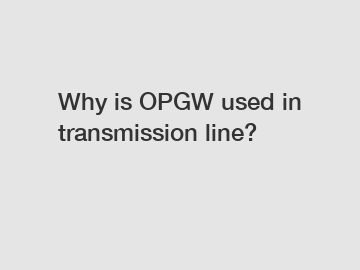Why is OPGW used in transmission line?
Why is OPGW used in transmission line?
OPGW, or Optical Ground Wire, is a specialized type of cable specifically designed for use in transmission lines. These cables not only function as a means of providing and distributing electrical power, but they also offer an additional optical communication channel. OPGW has become increasingly popular in the power industry, primarily due to its unique features and benefits. In this article, we will explore the reasons behind the widespread use of OPGW in transmission lines.
1. Enhanced Reliability and Safety:

One of the primary reasons why OPGW is extensively used in transmission lines is due to its enhanced reliability and safety features. The cable's design includes robust materials and construction that can withstand harsh weather conditions, including high winds and intense temperatures. This durability ensures uninterrupted power transmission and minimizes the risk of downtime or outages caused by cable failure. Additionally, OPGW incorporates optical fibers, which provide a dedicated channel for real-time monitoring of critical parameters, such as temperature and strain. By continuously monitoring these factors, potential issues or faults can be detected and addressed promptly, allowing for preventive maintenance and increased safety.
2. Efficient Utilization of Space:
Transmission lines are often located in areas with limited space availability. OPGW offers a compact solution by combining both power transmission and optical communication functionalities into a single cable. By utilizing the same physical infrastructure for both purposes, valuable space is conserved. This efficient utilization of space not only reduces the cost of establishing separate communication lines but also minimizes the overall environmental impact associated with transmission line installations.
3. Enhanced Communication and Data Transmission:
Optical fibers integrated within OPGW cables enable high-speed data communication, facilitating the transmission of vast amounts of information over long distances. This is especially advantageous for power companies as it allows for real-time monitoring, control, and coordination of the transmission grid. The optical fibers enable reliable and secure communication between different substations and control centers, enhancing the overall efficiency and stability of the power grid.
4. Lightning Protection and Electrical Grounding:
OPGW cables provide an effective means of protecting transmission lines against lightning strikes. The cable's metallic composition allows it to function as an electrical conductor, diverting the lightning current harmlessly into the grounding system. By dissipating the energy from lightning strikes, OPGW helps prevent damage to equipment, mitigating the risk of electrical faults and reducing the potential for safety hazards. This feature is particularly crucial in areas susceptible to frequent lightning activity.
In conclusion, the use of OPGW in transmission lines offers numerous benefits, including enhanced reliability, safety, efficient space utilization, improved communication, and lightning protection. These factors have contributed to the widespread adoption of OPGW by power companies around the world. As the demand for efficient and reliable power transmission continues to grow, OPGW's unique features position it as a valuable asset in modern electrical infrastructure. By incorporating both power and optical communication functionalities within a single cable, OPGW paves the way for a smarter, more resilient power grid.
For more coronaring, opgw tension clamp supplier, down lead clamp for opgwinformation, please contact us. We will provide professional answers.


